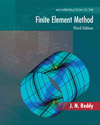
|  |
Book PrefaceThe third edition of the book, like the previous two editions, represents an effort to select
and present certain aspects of the finite element method that are most useful in developing
and analyzing linear problems of engineering and science. In revising the book, students
taking courses that might use this book as if textbook have been kept in mind. This edition
is prepared to bring more clarity to the concepts being discussed while maintaining
the necessary mathematical rigor and providing physical interpretations and engineering
applications at every step.
This edition of the book is a revision of the second edition, which was well received
by engineers as well as researchers in the fields of engineering and science. Most of the
revisions in the current edition took place in Chapters 1 through 6 and 14. Chapter 5 on error
analysis from the second edition is eliminated and a section on the same subject is added to
Chapter 14. Chapter 3 from the second edition is now divided into two chapters, Chapter
3 on theoretical formulation and Chapter 4 on applications. Chapter 4 on beams from the
second edition now became Chapter 5 in the current edition, making the total number of
chapters in both editions the same. Another change is the interchanging of Chapters 10 and
11 to facilitate the natural transition from plane elasticity to plate bending (Chapter 12).
New material on three-dimensional finite element formulations and nonlinear formulations
is added in Chapter 14. In all the chapters, material is added and reorganized to aid the
reader in understanding the concepts.
Most people who have used the earlier editions of the book liked the “differential equations
approach” adopted here. This is natural because everyone, engineer or scientist, is
looking for a way to solve differential equations arising in the study of physical phenomena.
It is hoped that the third edition of the book serves the student even better than the
previous editions in understanding the finite element method as applied to linear problems
of engineering and science.
The author has benefited by teaching an introductory course from this book for many
years. While it is not possible to name hundreds of students and colleagues who have
contributed to the author’s ability to explain concepts in a clear manner, the author expresses
his sincere appreciation to the following people for their help with the development of this
edition:
Ronald C. Averill, Michigan State University
Mahesh Gupta, Michigan Technological University
H.N. Hashemi, Northeastern University
Stephen M. Heinrich, Marquette University
Paul R. Heyliger, Colorado State University
John Jackson, University of Memphis
Mehdi Pourazady, University of Toledo
Robert L. Rankin, Arizona State University
N. Sukumar, University of California, Davis
Kumar Tamma, University of Minnesota
Chi-Tay Tsai, Florida Atlantic University
J. N. Reddy
jnreddy@shakti.tamu.edu
Tejashwina vadheetamasthu
(May what we study be well studied) |
|
|